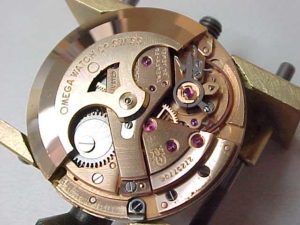In talking recently with another collector not as familiar with Omegas I was reminded of something that I haven’t seen mentioned lately: the discredited but oddly persistent myth of the “rose gold” finish on vintage Omega movements.
If you’ve been under the mistaken impression that those beautiful old vintage Omega movements were plated with rose gold, don’t feel bad. You’re hardly alone. Many collectors, watchmakers, and even Omega staff sometimes seem to suffer from the same misconception that “rose gold” finish contains actual gold content. In the initial January 2007 press release announcing the new 8500/8501 “in town” calibers, Omega appeared to be under the same misconception:
“In the case of the Calibre 8501, the rotor and balance bridge are fashioned out of 18 Ct red gold. The presence of 18 Ct red gold components is reminiscent of OMEGA’s rich watch making heritage as historically, red gold had been used in OMEGA movements.”
Sorry, Omega. That famous iconic “rose gold” finish for which vintage Omega movements became known actually didn’t contain any gold at all.
There are various reason for the persistence of the myth. It does admittedly look very much like rose gold. And perhaps there is some simple confusion with special calibers like the 863 that actually did have gold finishing.
Perhaps part of the reason too is just out of simple convention or convenience, or using “red gold” simply to refer to the coloration. But not all that glitters is gold.
Exasperated with the continued myth, collectors Paul Delury and Rob Berkavicius finally got together years ago to put it to the test. They sent samples of Omega parts to a metallurgical lab for a deliberate analysis.
After etching the parts with nitric acid and examining them under magnification, the metallurgist quickly determined that the finish was not gold at all:
“of similar composition, consisting of a brass-like body thinly coated with copper. The brasss-like body is unusually hard and tough, and is believed to be beryllium bronze, a copper-base alloy continisng 2.25% beryllium; this alloy responds to temper-hardening, devleoping great hardness after suitable treatment… No gold was identified.“
Link: “All That Glitters?“ – Rob Berkavicius (Rob B)



I was trying to ask a question about the ‘Definitive Guide…”, but could not find any way to leave a comment there….so here goes…
Does winding an automatic on a regular basis cause any damage, e.g., my vintage Omega runs down over the weekend, or if I don’t wear it for a couple of days. A watch winder is a solution, but what if I just wind it fully (15 winding turns) on Sat and Sun night so it is still running on Monday morning?
Hello to all out there
Recently I purchased a vintage omega seamaster Stainless steel made 1963 Although to mention that it needs a service & the Clutch needs Adjusting I’m not a watchmaker but a Good Watchmaker diagnosed the problem over the Phone Another Thing that Puzzles me is that these Seamasters are undervalued The Extremely High Quality of these Watches Should fetch Much Higher Prices I’ve seen Seamasters sell for as low as USD500- To be really Honest in my Opinion Omega is better then Rolex & I wouldn’t swop mine for a Rolex That’s my View Thanks & Best Wishes for 2025 Derek Solomon Johannesburg South Africa